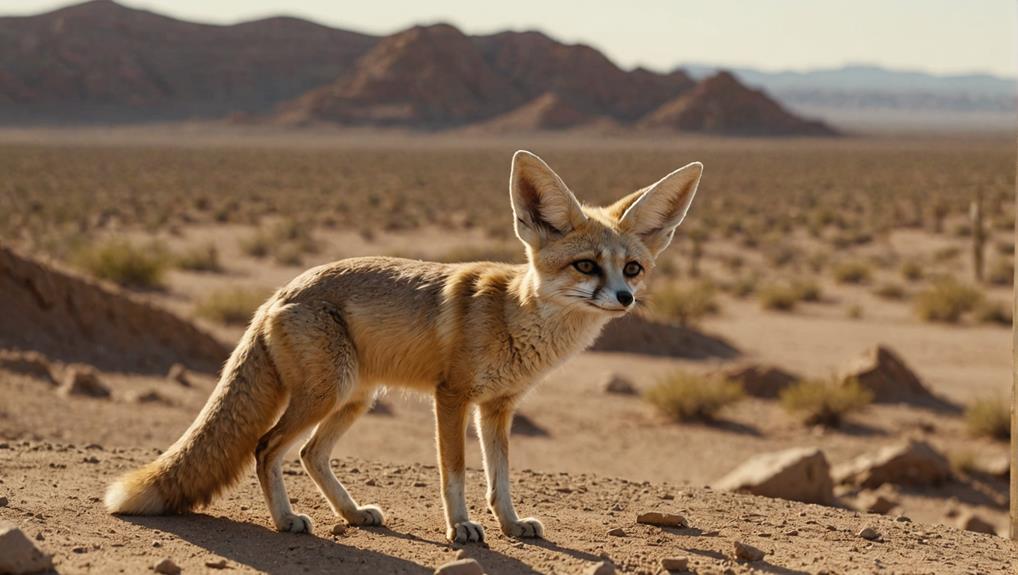Fennec foxes, those cute little critters with giant ears, prefer the warm, sandy, and rocky deserts of northern Africa, especially the Sahara. They love stable sand dunes where they can dig deep burrows—up to 32 feet long—to escape the sweltering heat and hide from predators. These crafty foxes are nocturnal, coming out at night to hunt insects and small rodents, allowing them to avoid the daytime sun. Sadly, human activities like urbanization threaten their homes. So, if you're curious about how these adorable foxes survive in such a tough environment, you might discover some fascinating insights!
Contents
Overview of Fennec Foxes
Fennec foxes, the smallest species of fox, are fascinating creatures that primarily inhabit the sandy and rocky deserts of northern Africa, particularly the Sahara. These little wonders have a knack for thriving in environments with sparse vegetation, making them perfectly suited for the harsh desert life.
They dig dens that can reach depths of up to 3 feet, which help shield them from the extreme daytime heat and chilly nights.
You'll find Fennec foxes in stable sand dunes, where they can forage and burrow without the worry of human disturbances. Isn't it amazing how they can tolerate a range of habitats, even coastal dunes along the Atlantic?
Their nocturnal lifestyle is key to their survival, allowing them to evade the scorching daytime temperatures and hunt effectively under the cover of night.
However, it's important to mention that habitat loss poses a significant threat to these adorable animals. As their homes shrink due to human activities, we must work together to protect these unique creatures and their precious habitats.
Desert Ecosystems and Adaptations
How do desert ecosystems support the survival of unique species like the fennec fox? These remarkable little creatures are perfectly adapted to thrive in sandy deserts and arid regions of northern Africa, especially in the Sahara. Their home is often marked by stable sand dunes, where they feel right at home.
Fennec foxes are true survivors, showcasing incredible adaptations that help them navigate their challenging environment. For instance, their heavily furred paws protect them from the scorching hot sand—think built-in sandals!
They also dig extensive burrow systems that can stretch up to 32 feet, offering them shelter from the blazing sun and potential predators.
In these dry conditions, where annual rainfall barely hits 100 mm, fennec foxes get creative. Instead of searching for water, they obtain moisture from their diet, which is a smart way to beat the heat.
With minimal vegetation around, they rely on nearby scrub for foraging and burrowing opportunities. It's fascinating how these tiny foxes have adapted to make the most of their sandy desert home, turning challenges into unique strengths that allow them to thrive.
The Burrow: A Safe Haven

When you think about fennec foxes, imagine them burrowing into the sandy dunes to create their cozy homes.
These clever little critters not only keep cool during scorching days but also stay safe from predators lurking above.
Let's explore how their burrow construction techniques, temperature regulation strategies, and clever ways to avoid danger make these underground havens a true sanctuary.
Burrow Construction Techniques
In the arid landscapes where these clever creatures thrive, the construction of burrows is a testament to their adaptability. Fennec foxes dig intricate burrow systems, extending up to 32 feet, providing vital shelter from extreme temperatures and sneaky predators. Typically, these burrows are dug into sandy substrates, which offer fantastic insulation against the harsh desert climate.
Here's a quick look at the fascinating features of their burrows:
| Feature | Description |
|---|---|
| Burrow Depth | Can reach about 3 feet, perfect for escaping heat and cold. |
| Chamber System | Multiple chambers promote ventilation and serve as escape routes. |
| Location | Often found in stable sand dunes, ideal for hunting and raising young. |
These burrows aren't just cozy homes; they stabilize temperature, keeping the fennec foxes comfortable no matter the weather outside. So, next time you think about these adorable little foxes, remember the amazing, innovative homes they've crafted to survive and thrive in their challenging environment. Isn't nature just incredible?
Temperature Regulation Strategies
Many mightn't realize just how vital the burrow is for fennec foxes, serving as a sanctuary that expertly regulates temperature.
These clever creatures dig burrows that can reach up to 32 feet deep, which helps them escape the extreme heat of the desert. Imagine having a cozy, cool hideaway while the sun blazes outside!
Here are some amazing features of their burrows:
- Insulation: Keeps the burrow cooler during scorching days.
- Temperature regulation: Warmer at night for those chilly desert evenings.
- Protection: Safeguards against predators and harsh weather.
- Habitat preferences: Adapted to sandy substrates, perfect for digging.
Predation Avoidance Tactics
The burrow serves as a crucial safe haven for fennec foxes, allowing them to evade predators effectively. These clever little creatures dig extensive burrow systems that can stretch up to 32 feet long! In the arid ecosystem where they live, these burrows provide not just shelter but also insulation from the extreme temperatures that can be a bit too much for any creature.
During the day, when the sun is blazing, fennec foxes snuggle underground, using their nocturnal behavior to stay safe and conserve energy. By hiding from birds of prey and other daytime threats, they ensure their survival while staying cool and comfy.
Here's a glimpse of how their burrows help them dodge danger:
| Burrow Feature | Purpose | Emotional Impact |
|---|---|---|
| Length (up to 32 ft) | More hiding spots | Safety and security |
| Thick walls | Insulation from heat | Comfort and relief |
| Underground refuge | Escape from predators | Peace of mind |
| Sandy environment | Easy digging | Adaptability and resilience |
| Energy conservation | Efficient foraging | Thriving in harsh conditions |
Nocturnal Behavior and Temperature Regulation
When you think about fennec foxes, picture them bustling around under the cover of night, searching for food while it's cooler outside.
Their clever adaptations, like those oversized ears that help them hear prey underground, show just how well they've mastered life in the desert.
Plus, with their thick coats and cozy burrows, they've got some serious tricks up their sleeves for keeping comfortable, no matter how hot or cold it gets!
Nocturnal Foraging Habits
In the harsh desert environment, fennec foxes have adapted their foraging habits to thrive under the cover of darkness.
These nocturnal hunters prefer to emerge at dusk, avoiding the blistering heat of the Sahara Desert during the day.
With their large ears, measuring up to 15 cm, they can hear the slightest rustle of prey while also helping to regulate their body temperature at night.
By foraging at night, fennec foxes not only find food but also keep themselves safe from daytime predators.
Here are some fascinating aspects of their foraging behavior:
- They primarily hunt insects, small rodents, and plants.
- Their burrows, which can go as deep as 3 feet, serve as cozy homes and shelters from the heat.
- They rely on the moisture in their food, so they thrive with minimal water intake.
- Their keen sense of hearing allows them to locate prey even beneath the sand.
Temperature Adaptation Strategies
Fennec foxes have developed remarkable temperature adaptation strategies that allow them to thrive in extreme desert conditions. Their secret? Being nocturnal! By emerging at dusk, you'll find them avoiding the blistering daytime heat that often soars above 100°F (38°C).
Those large ears of theirs, measuring up to 6 inches, aren't just for show; they help dissipate heat, keeping their body temperature in check.
Plus, their heavily furred paws protect them from hot sand, making it easy to scurry about in their warm environment.
When night falls and temperatures drop, their thick, sandy-colored coat provides excellent insulation, ensuring they stay warm even in the chilly desert air.
But that's not all! Fennec foxes dig burrows, sometimes reaching depths of 3 feet, where they create a cooler microenvironment to escape the sweltering daytime heat.
It's like their little underground hideaway! So, the next time you think of these adorable creatures, remember how they cleverly manage temperature extremes.
Their adaptations not only help them survive but thrive, and it's a fantastic reminder of nature's ingenuity!
Social Structure and Interactions

Throughout their lives, fennec foxes primarily embrace a solitary existence, often hunting and foraging alone. However, these adorable creatures do have fascinating social interactions, especially during certain times of the year.
They establish and defend their territories, marking their areas with urine and feces to communicate with others. You might say they've their own "do not enter" signs!
During the breeding season, fennec foxes showcase their monogamous behavior, forming lasting pair bonds with a single mate. It's like finding your partner in crime!
Their familial structures are equally charming, with mothers taking the lead in caring for the kits while the dads lend a helping hand by providing food.
Here are some key points to remember about their social structure:
- Fennec foxes are primarily solitary, but they form strong family ties.
- They communicate through a variety of vocalizations, from whimpers to growls.
- Territories are vital for their social interactions and survival.
- Monogamous behavior shines during the breeding season.
These little foxes remind us that while they may enjoy their alone time, family and connections matter too!
Dietary Habits and Hunting Strategies
Nocturnal by nature, fennec foxes thrive in the desert's darkness, hunting primarily at night to escape the sweltering heat and competition from daytime predators. Their diet is quite interesting—these little foxes are omnivores! You'll find them munching on insects like grasshoppers and locusts, along with small mammals, lizards, and even plants. They've a knack for finding hydration in fruits and roots, which is quite clever!
Fennec foxes are true nocturnal hunters, using their acute hearing to detect prey hiding underground. Imagine that! With those big ears, they can hear a tiny critter scurrying beneath the sand and dig it up with impressive skill. They're not just catching easy meals either; they can even tackle prey larger than themselves, like small rodents and rabbits.
Their adaptability in hunting strategies is really something to admire.
What's even cooler is that fennec foxes can go long stretches without drinking water. They cleverly get their moisture from their food. So, next time you think about hydration, remember these resourceful little foxes thriving in the desert!
Impact of Human Activities

The impact of human activities on fennec foxes is significant and troubling. As we encroach on their habitats, we're not just taking away their homes; we're affecting their very survival. Urbanization and agricultural development in northern Africa are destroying the spaces they rely on, leading to habitat loss and fragmentation.
Here's what you should know:
- The exotic pet trade puts direct pressure on local fennec fox populations.
- Road construction increases risks of vehicle collisions for these adorable creatures.
- With less space, their natural behaviors and social structures get disrupted.
- Public awareness and conservation efforts are crucial to help these foxes thrive.
We all need to step up! By supporting responsible tourism and advocating for habitat protection, we can make a real difference. It's not just about saving the fennec fox; it's about preserving a unique part of our planet's biodiversity.
When we care, we can spark change. So, let's spread the word and ensure that future generations can enjoy the delightful antics of fennec foxes in their natural desert homes. After all, who wouldn't want to see those big ears bouncing around in the wild?
Final Thoughts
So, fennec foxes are pretty amazing creatures, thriving in harsh desert habitats thanks to their clever adaptations. Their burrows provide a cozy retreat, while their nocturnal lifestyle keeps them cool and safe. Plus, their social interactions and unique hunting skills make them even more fascinating. However, with human activities encroaching on their homes, it's essential we protect these adorable little guys. After all, who wouldn't want to keep these furry desert dwellers around for years to come?














